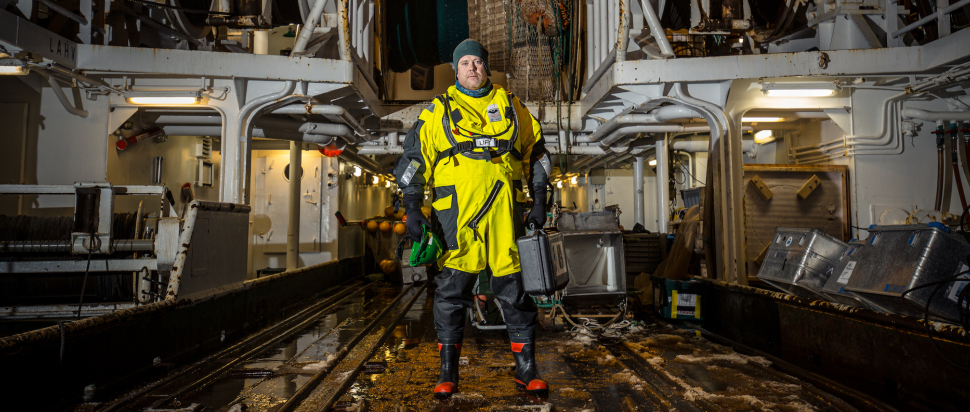Into the Dark takes us into the Polar Night
American filmmaker and photographer Michael O Snyder plunges us into the Polar Night with his latest documentary Into the Dark, which follows a team of scientists studying the Arctic's hardiest marine life
It’s February and you’re most likely reading this in Scotland, therefore you probably know a thing or two about the dark. Spare a thought, then, for the inhabitants of Tromsø, Norway, where the sun hasn’t risen above the horizon since November. Michael O Snyder’s new documentary, Into the Dark – which screens as part of Curious About: Our Planet, Glasgow Science Centre’s digital science festival – opens in Tromsø, and takes us even further north. It follows a team of scientists on the Helmer Hanssen research vessel – comprised of a crew from UiT The Arctic University of Norway and the Scottish Association for Marine Science – who are examining how the world’s most hardy sea creatures survive Polar Night, the Arctic’s months of endless darkness.
Snyder explains that, until recently, the orthodox view of Arctic life during Polar Night was that it was functionally dead. “The thinking was there's no light at the North Pole for six months, and without light, there's no primary production, there's no plants to eat, you can't see to reproduce, you can't hunt. So essentially, life goes dormant.” Around a decade ago, however, scientists discovered that was not at all the case. “It turns out the environment there is so fine-tuned and so evolved that it functions with truly infinitesimal amounts of light, like a millionth of what we can see.”
What the team of jovial Scots and stoic Scandinavians are particularly interested in is how climate change will affect this light-sensitive habitat. As the Arctic ice thins and recedes thanks to increasing temperatures, more light will be able to penetrate these once perennially dark ocean waters. The only way to study these light-sensitive sea creatures is for the Helmer Hanssen to switch off all its lights and the scientists take their readings in complete darkness. Conducting delicate scientific research in such conditions is, shall we say, tricky. And making a film is no picnic either.
“It was an enormous technical challenge,” confirms Snyder. “Cameras essentially paint with light, so in the absence of light, what do you do?” Well in the first instance, Snyder was assisted by some cutting edge tech. “The timing of the filming was quite fortuitous, with GoPro and Sony both releasing brand new sensors right before the production started on the film,” he explains. “We were very pleasantly surprised by our ability to see in that darkness with some of this technology. And of course, that was mirroring the technology that the scientists were using, because they are also trying to quite literally see in the dark.”
Snyder’s other technique for capturing the eerie atmosphere of Polar Night was much more straightforward: “Very early on we made the editorial choice to allow the audience to just sit in darkness for a little bit, because the truth is, it's just very, very dark.” This blunt-force effect, of course, would have been particularly powerful in a pitch-black cinema space, but unfortunately Curious About: Our Planet's programme is fully online, so be sure to have your lights off while you watch at home.
Beyond the technical issues, the biggest challenge any environmental documentary filmmaker faces is to create a film that’s more than just a portal through which to dispense facts. Thankfully Into the Dark is as compelling narratively and aesthetically as it is informative. “I see my job as to tell great stories,” says Snyder. “So we're not simply just presenting lots of information, we're getting underneath that, we're getting into why people do what they do, and what the emotional experiences are like doing that." Not only does this make the film more enjoyable to watch, it's more likely to sock its message across too. "All the research tells us that the data on its own is not enough to move most of us towards a more sustainable lifestyle. As human animals, we are rational to a certain extent, but we're also emotional and connections oriented. So telling a good story is vital.”
Snyder's films have taken him to different communities with different issues all over the world, from the water crisis in Uganda to ancient dream cultures living in the Amazon, but climate change has been a throughline. “There are so many issues that need to be addressed in this world but the thing about climate change is that it's a magnifier for all other issues,” Snyder says. "If we get it wrong on climate change, we get it wrong on everything, whether you're working on security issues, whether it's violence, whether it's migration, whether it's public health, whether it's species protection, water access, it doesn't make a difference.”
Curious About: Our Planet runs online 18-20 Feb
Into the Dark has its UK premiere on 19 Feb at 8pm, followed by a live Q&A with Michael O Snyder and research scientist Dr David McKee, who features in the film
curiousabout.glasgowsciencecentre.org
